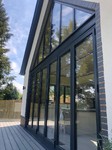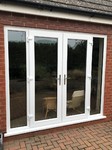
Door Styles & Types Guide
One of the simplest ways to enhance your home is by installing a well-designed exterior door. A door serves a vital function of security and so choosing the right style is critical. Here is a walkthrough on different styles of exterior doors for every threshold at home.
Comparing composite doors to wooden/timber doors, and glass doors
Composite doors are designed with a combination of materials that are pressed to create a uniform structure.
Examples of materials for composite include glass-reinforced plastic, insulating foam, wood, and uPVC. Crafted with the latest technology, these materials make a strong and secure single door. Those featuring a foam core enclosed by Glass Reinforced Plastic have remarkable insulating qualities. They provide more benefits compared to doors made of timber or glass alone. Composite doors are therefore the superior choice for securing a home. In terms of resistance to harsh weather and maintenance they are also a great choice.
Traditional timber doors are naturally beautiful, but can be costly and could warp with time. This means they require more care and maintenance. T&R uses Accoya timber meaning less frequent maintenance.
Glass doors, on the other side, are easy to clean and can hold up to high temperatures better. But they can be cracked easily and require an extra layer of curtains to maintain privacy in the house.
With high-quality composite doors, you don't need to worry about warping, fading, cracking, and repainting.
Are bi-fold and French doors the same?
The two styles are slightly different. A big house that requires sufficient lighting should have bifold doors. These are designed with multiple panels that can fold back and open up the living room fully. They are also known as folding glass doors or glass walls. Each panel is attached to another by hinges to allow the whole door to fold in in a concertina.
The bifold style reduces the exterior surface area that the door must open into. As such, it becomes easier to design huge doors that do not encroach outwards. Bifolding doors are adaptive- panels can be switched to one side to allow the door to collapse in one direction. Both can also be attached to let the door open in two directions.
French doors are the opposite of sliding patio doors. A patio door is normally opened through track sliding. But a French door uses hinges to open just like a traditional entrance. However, it is bigger than interior louvre door and consists of two glass panels. It opens the same way a regular door does.
What's the difference between them?
Compared to French doors, bifold doors do not take any floor space when open. Bifolds bring a panoramic view by opening up the whole wall. The frames are slim but they break up the scene when shut. Generally a bifold patio door costs more to install than a French or sliding door. When it comes to the view, French door is not as expansive as a bi-fold door. Because they are smaller in size, the French doors cost less, making them the most affordable option.
Which type of door works best where?
Looking for a wider closet 6 ft. or wider? Then a pair of bi-folding doors is the best option. Bi-fold doors are ideal for maximizing the interior space.
If you need a charming touch with extra-wide doorway for a traditional property, the French style is the way to go. The glass panels are common with patio doors and make stunning passages between rooms. A sliding door is best suited to contemporary houses especially when uPVC is used.





